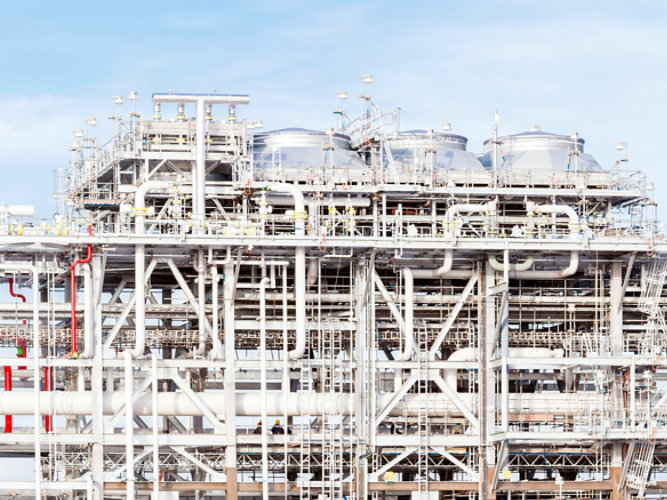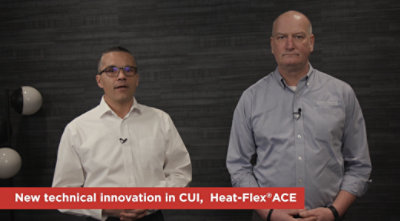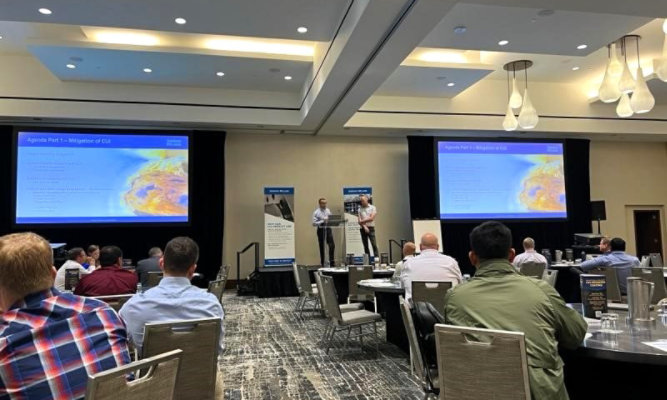How Liquid Coatings Curb Corrosion Under Insulation (CUI) in LNG Service
High Performance Solutions Deliver Longer Maintenance-Free Operations
by Mark Rubio, Energy Business Manager, and Neil Wilds, Global Product Director – CUI, Sherwin-Williams Protective & Marine

From upstream operations to midstream infrastructure to downstream applications, the oil and gas industry faces a host of hidden dangers related to corrosion under insulation (CUI). That includes on assets used for the production of liquified natural gas (LNG), which are often insulated to prevent heat exchange in cryogenic applications and to retain process heat and protect workers in hot applications (Figure 1).
CUI is a severe form of localized corrosion. It takes hold when water, inorganic salts and other contaminants become trapped beneath the insulation that’s commonly used to cover process pipes, industrial valves, storage tanks and other assets. Those elements work together to form corrosion cells on the steel substrates found under insulation. Hidden from view, the corrosion can proliferate and spread unnoticed, leading to pitting and metal loss that may cause leaks and potentially catastrophic failures (Figure 2).
Both heated and cryogenic processes are subject to the threat of CUI, as a perfect recipe for corrosion exists in both temperature scenarios – that being a combination of moisture, oxygen and chlorides. With those elements in contact with steel substrates under insulation, elevated LNG processing temperatures can naturally accelerate corrosion rates. In addition, cold/cryogenic temperatures found in many LNG operations cause moisture from condensation to be especially prevalent under insulation, contributing to increased CUI risks. In fact, studies show that moisture causes 85% of insulation system failures in LNG operations.
While carbon steel is commonly used in oil and gas refining operations, LNG refinery applications typically feature stainless steel. The more durable material offers added strength, hardness and corrosion resistance, which helps LNG facilities better protect assets, including those operating at very low temperatures. While better able to combat generalized corrosion than carbon steels, stainless steel is still susceptible to corrosion, particularly chloride stress corrosion cracking (CSCC) when chlorides from salts are in contact with the metal. This is true whether the chlorides are trapped in a salty solution on the metal’s surface under insulation or if they sit on the surface of exposed steel. With CSCC, tiny cracks develop on the surface of stainless steel (Figure 3), weakening its structure, potentially to the point that a gas leak develops or an explosion occurs.
A primary way to combat the hidden threat of CUI is to apply protective coatings on the surfaces of assets that will be covered with insulation. The coatings create a barrier between the metal substrate below and the chlorides, moisture and other exposures on the surface. They are an essential part of an insulation system, serving to mitigate the corrosion process for as long as possible so assets can operate longer before maintenance is needed.
The common lifespan of traditional organic coatings used in CUI service ranges from only 5 to 13 years before facilities must engage in costly recoating efforts. However, that time frame is expected to extend significantly as advanced coating technologies come to market. Such solutions are designed to better address a variety of common coating failure mechanisms, thereby enhancing performance and extending the life of coated assets. For example, advanced coatings are better able to withstand elevated and extremely low operational temperatures, exposure to chlorides, rough handling during transport, exposure to ultraviolet (UV) light when assets are stored outdoors prior to installation, and high moisture conditions related to humidity and condensation. The new liquid coatings are performing better than traditional CUI coatings, helping LNG facilities protect their bottom lines by extending coating maintenance schedules. In addition, the coatings are also faster, easier and more economical to apply compared to the thermal sprayed aluminum (TSA) material that is sometimes used to combat corrosion in LNG applications.
The Perfect Environment for CUI
Because LNG assets can operate at temperatures as low as -260°F (-162°C), effective thermal insulation systems are required to prevent those assets from experiencing excessive heat gain. The insulation also helps to maintain low process temperatures to ensure effective and safe operation.
With numerous projects planned to meet growing global LNG demands, the need to better address CUI is pressing. LNG operators will need proven, cost-effective CUI-mitigation solutions that improve safety and long-term productivity as they expand existing facilities and construct new ones. This is especially true in the hot, humid coastal environments where many LNG facilities are located. In these environments, salt in the atmosphere will inevitably collect on the surfaces of piping and other equipment. That includes on new assets that are shipped to the project site without insulation. Along the way, atmospheric chlorides may settle on the surface of those assets and not be washed off before on-site installers add insulation systems. Because roughly 60% of insulation systems pick up corrosion-inducing moisture over time due to cracks and gaps that form in the protective cladding installed over top, any chlorides trapped under insulation are likely to encounter water, creating a corrosive solution as the chlorides dissolve in the moisture. In addition, salts that settle on the surface of cladding can dissolve from exterior moisture and then leach into the insulation system via gaps, adding more fuel for the corrosion process.
The resulting highly corrosive solution that occurs when water and chlorides are trapped within insulation systems creates an ideal scenario for CUI to take hold – whether the steel substrate has been coated or not. Naturally, if the asset has been coated, the corrosion process will be slower. Regardless, adding process heat to the equation increases the corrosion potential because the corrosive solution may boil on the substrate. In some cases, that heat will enable trapped moisture to evaporate, which is helpful. However, spots of concentrated chloride may remain on the steel surface, contributing to increased corrosion potential. In other cases, the insulation will remain wet, with a salty solution in constant contact with the substrate. In either scenario, the chlorides in contact with carbon and stainless steels can lead to CUI forming. With stainless steels, that CUI will commonly present in the form of CSCC.
CSCC will often go unnoticed until a facility performs its next insulation inspection. Even then, it may be hard to spot, as it causes tiny surface cracks that are imperceptible to the human eye to develop and spread along microscopic grain boundaries within the stainless steel. The cracks typically follow the direction of the highest tensile stress on the metal. Over time, the steel may become weak and brittle to the point that it cracks open, causing leaks or more catastrophic events that threaten safety and lives. Such failures are often sudden and unexpected. Adding to risks, they are also more likely to occur when processes are running at elevated temperatures.
CUI can occur in a broad band of temperatures. It is of most concern on insulated carbon steel assets operating at temperatures between 32°F (0°C) and 302°F (150°C) and is the most severe at about 200°F (93°C). With austenitic stainless steel piping systems, they are the most susceptible to CSCC forming under insulation when operating between 140°F (60°C) and 400°F (205°C).
Using Coatings to Mitigate CUI and CSCC
Some sort of protective coating is required on stainless steel or carbon steel substrates to mitigate the issues of CUI and CSCC in LNG operations. The coating will help to maintain a barrier between the substrate and the corrosive exposures on the surface – whether an asset is insulated or not.
The type of exposures an asset will encounter will influence the type of coating that’s best suited to combat CUI in a given application, as different technologies offer a range of performance. Those exposures include cryogenic and elevated temperatures; chloride, moisture and UV exposures; and surface damage. Facilities may also consider the total cost of ownership for the protective coating application, including the initial costs to coat an asset and subsequent costs encountered when recoating that asset in the future.
One option LNG facility managers have for coating stainless steel assets is thermal sprayed aluminum (TSA). While this option can provide up to 25 to 30 years of maintenance -free CUI service, it has very high application costs and impacts on sustainability. The application process is cumbersome and the aluminum material is applied using energy-intensive spray equipment. Applicators must be very meticulous during surface preparation, carefully abrasive blasting the entire substrate, performing tape tests to eliminate dust contamination and testing for salt contamination to ensure a contaminant-free surface. The TSA application process requires the same attention to detail, as applicators must spray multiple layers of molten metal particles onto steel surfaces, check the layer thickness frequently and often apply a topcoat sealant.
Other popular options to protect stainless steel from succumbing to CUI include spray-applied organic liquid coatings, such as high-temperature epoxy phenolics; high-temperature, high-solids alkylated amide epoxies; and ultra-high-solids novolac amine epoxies. Like in TSA applications, personnel still need to carefully abrasive blast the entire steel surface of an asset to create a proper anchor profile for coating adhesion and ensure no contaminants remain on the surface. However, the liquid coatings are much faster, easier and less expensive to apply than TSA.
Some of the best performing liquid coating options for combatting CUI and CSCC include newer formulations that feature minimum concentrations of 25% micaceous iron oxide (MIO) pigment (Figure 4) by weight in the dried coating film. This heavy load of MIO reinforcements imparts enhanced properties into the coatings to deliver greater durability against impacts, chemicals and corrosion compared to other formulations. Within the dried coating film, flakes of MIO line up parallel to the substrate surface and form a layered barrier that deflects UV rays (Figure 5) and provides enhanced UV erosion resistance to protect the epoxy-based coatings from degrading before insulation is installed on assets. The MIO flakes also slow down the penetration of moisture, oxygen and other elements into the coating, thereby enhancing corrosion protection.
Among the newer MIO-enhanced liquid coatings on the market, a two-component, high-solids alkylated amide epoxy (AAE) coating offers excellent long-term asset protection from CUI (Figure 6). The coating has consistently outperformed traditional epoxy phenolics and other AAE technologies in various testing. That includes better heat, corrosion, erosion and thermal shock performance in corrosive offshore CX environments, as well as excellent heat and crack resistance at high dry film thicknesses (DFTs). The coating also offers epoxy-type mechanical resistance, which helps to minimize the potential for coatings damage to occur as coated steel assets are transported. Finally, the coating features much less solvent than other AAE CUI-mitigation coatings – with a volume solids of 78% compared to 65% for typical alternatives – helping the environment.
A newer ultra-high-solids advanced CUI epoxy novolac coating offers even better performance than the MIO-enhanced formulations. It features a functional chemical enhancement to mitigate CUI and represents a new class of CUI-mitigation coatings because it is free from flake-filled pigmentation. The ultra-high volume solids coating is also solvent free, making it more sustainable than alternative CUI-mitigation epoxies, which are typically 60-80% volume solids formulations. With minimal to no volatile organic compounds (VOCs) released from the ultra-high volume solids coating, applications offer better environmental stewardship by reducing their overall carbon footprint. Applicators can also realize lower permitting costs for their shops.
The advanced ultra-high-solids CUI epoxy coating far surpassed the capabilities of solvent-based epoxy phenolic and novolac coatings designed for CUI mitigation in various tests. For example, the coating provided the most versatile DFT range among CUI-mitigation coatings. It also had the best temperature, corrosion, chemical and mechanical resistance. Tests included various heat cycling, simulated CUI, BS EN 927-6:2016 UV erosion and DFT tolerance protocols. In addition, ISO 12944-9 CX cyclic anticorrosion testing and a series of CUI simulation tests performed in accordance with AMPP TM21442 in excess of 204°C (400°F) delivered excellent results.
Tested against the ISO19277:2018 standard, which uses a vertical pipe test method known as the “Houston pipe test,” both the AAE and ultra-high-solids epoxy novolac coatings performed well. The test helps to verify a coating’s resistance to accelerated CUI conditions with periodic shutdown periods.
Mitigating CUI for the Long Haul
CUI is a persistent problem when steel assets are covered in insulation and is therefore inevitable in many LNG facilities. In particular, stainless steel assets exposed to chlorides are especially susceptible to CSCC forming under insulation. However, facility owners can slow the corrosion process and reduce the total cost of ownership for LNG production assets by applying some sort of protective coating to any insulated asset. They should also coat most non-insulated assets, as any atmospheric chloride exposure could lead to CSCC. Applying such coatings will help facilities mitigate the dangers of CUI and CSCC for safer overall operations.
When making a coating selection, it’s helpful to know that various liquid organic coatings show great promise in testing for mitigation CUI over the long term, making them likely to become preferred specification solutions. Of note, the epoxy novolac formulation described above offers the ability to mitigate the corrosion process significantly longer than the traditional coatings that have been used in the industry until now.
ABOUT THE AUTHORS
Mark Rubio serves as Energy Business Manager for Sherwin-Williams Protective & Marine and has 28 years of international coatings experience, primarily in the energy segment working on major global oil and gas industry projects. He provides engineering and project support to owners and engineering, procurement and construction (EPC) firms specializing in areas such as corrosion under insulation (CUI), fireproofing, linings, subsea and atmospheric coatings. He is an AMPP Certified Coatings Inspector and member of several AMPP committees. Contact: Mark.A.Rubio@sherwin.com
Neil Wilds is Global Product Director – CUI for Sherwin-Williams Protective & Marine. With 37 years of technical coatings experience, Wilds develops strategies for long-term asset protection and directs the development of specifications and testing programs. He is a member of several coatings associations including AMPP, NORSOK M501, the International Organization for Standardization (ISO) and others. Contact: Neil.Wilds@sherwin.com
Figure 1. Many LNG assets face an elevated risk for corrosion under insulation (CUI) to develop and proliferate.
Figure 2. Eating away at steel substrates, CUI may eventually weaken the metal and cause dangerous leaks or explosions to occur.
Figure 3. Chloride stress corrosion cracking (CSCC) on type 304 stainless steel causes microscopic surface cracks to form, weakening the steel’s structure and making it susceptible to potential gas leaks.
Figure 4. Various liquid coatings featuring high concentrations of micaceous iron oxide (MIO) pigment embedded in them offer enhanced durability against impacts, chemicals and corrosion.
Figure 5. MIO flakes embedded in coatings form a parallel, plate-like barrier that deflects UV rays and slows the penetration of moisture, oxygen and other elements into the coating.
Figure 6. MIO-enhanced, high-solids alkylated amide epoxy coatings offer excellent protection from CUI on assets such as industrial valves used in LNG processing.
Discover More
Industry Expertise and Innovation
See how we help customers find customized solutions for their project and application challenges.
Our Oil & Gas Expertise
Explore our industry solutions and technology to help protect your assets.
LEARN MOREProduct Lookup
Find out more about our innovative coatings for a variety of industries.
FIND A PRODUCT


